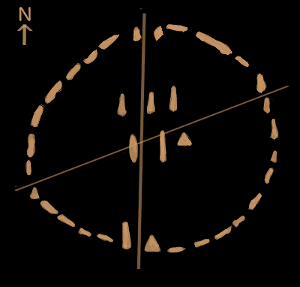During the early Holocene (9000 – 6100 BC) the area around Nabta Playa (west of Abu Simbel in the Western Desert) flooded seasonally creating a lake surrounded by grasslands which attracted Neolithic nomadic tribes. They would make temporary camps to take advantage of the pastures to feed their cows and goats and supplement their diet by hunting and gathering.
Around 7500 years ago there was a notable change in the culture of the peoples of the Nabta Playa. Exhibiting a degree of social organization not previously seen in ancient Egypt, they began to sacrifice young cows and bury them in clay lined chambers. In what has become known as the “Valley of Sacrifices” there are ten identifiable mounds of broken sandstone blocks. The subterranean chambers beneath them contain the articulated remains of cattle, goats, and sheep. The largest (and also possibly the oldest) contains an entire cow in an elaborate chamber covered by a tamarisk roof. The carcass is oriented roughly north to south, lying on its left side, with its head facing to the west.

At the end of the wadi there is a small stone circle around twelve feet in diameter. Two pairs of stone slabs mark out the north and the position of the rising of the sun on the summer solstice (the beginning of the rainy season). There are six further upright slabs set along two lines, the astronomical purpose of which is hotly debated. There is also an east-west alignment connecting one megalithic structure with two stone megaliths about a mile away and two other geometric lines involving about a dozen additional stone monuments that lead both north-east and south-east from the same megalith. During the summer and autumn months the complex would have been partially submerged, which may also have been an important aspect of its symbolic geometry.

Astrophysicist Thomas G. Brophy suggested that the southern alignment of three stones represented the stars of Orion’s Belt, and another three his head and shoulders. He proposed that their positions corresponded with a date of around 4800 BC or 16500 BC. He suggested a connection between the southernmost alignment of stones and Sirius with a date of around 6088 BC. He also proposed that the larger stones set near to the so called “calendar circle” were also aligned to these stars, setting a date of around 6270 BC. Finally, he proposed that the table rock was a map of the Milky Way at around 17500 BC and that the stars mapped Orion at around 16500BC. Recently, in a book co-authored by Graham Hancock, he suggests that the circle is evidence of contact with “some other intelligence” – i.e. aliens.
Malville, Wendorf, et al, have questioned his dates and other more colourful interpretations dating the circle to a period between 4500 and 3600 BC. They propose that the three northernmost alignments point to Arcturus (the brightest star in the northern celestial hemisphere), a forth alignment links with Sirius and Alpha Centauri (the brightest and third brightest stars at that time), while a fifth alignment points to Alnilam in Orion’s Belt. They acknowledged a correction made by Brophy to the alignment of the line pointing to Sirius, but did not accept the conclusion that this produced a date of 6088 BC, noting that it is hard to be certain of astronomical alignments because of the movement of the sand and significant damage to the stones in the thousands of years since the stones were erected. They point out that there is absolutely no evidence of settlements outside the Nile Valley before 9000 BC.
The timeframe they propose is that Nabta Playa became an important ceremonial and cultural focal point for the Neolithic people of the Sahara between 6100 and 5600 BC. These people came from miles around to preform sacrifices (as evidenced by the presence of hearths) but did not settle the area.
In 5500 BC, following a hyper arid period, Neolithic people returned to the area and interred cattle in the clay lined tumuli of the “Valley of Sacrifices”. At around 4800 BC the stone circle was erected to mark the summer solstice, and further megalithic structures followed until around 3600 BC. The rich burials of the Gebel Ramlah cemetery nearby are dated with a reasonable degree of certainty to around 4400 BC, and it is these prehistoric herdsmen who they consider to be the likely builders of the stone circle and associated megalithic structures.
Bibliography
- Allen, James P. (2010) Middle Egyptian
- Bard, Kathryn (2008) An introduction to the Archaeology of Ancient Egypt
- Grajetzki, W (2003) Burial Customs in Ancient Egypt
- Kemp, Barry J (1991) Ancient Egypt: Anatomy of a Civilisation
- Hendrickx. S, Vermeersch, P (2000) “Prehistory”, in The Oxford History of Ancient Egypt Ed I. Shaw
- Malvill. J.M, Schild. R, Wendorf. F, Brenmer. R “Astronomy of Nabta Playa” in “African Cultural Astronomy: Current Archaeoastronomy and Ethnoastronomy research in Africa” (2007) Edited by Holbrook. J, Medupe.R.T, and Urama. J.O
- Wendorf. F, Schild R “Nabta Playa and Its Role in Northeastern African Prehistory” from the Journal of Anthropological Archaeology 17, 97–123 (1998)
Copyright J Hill 2016